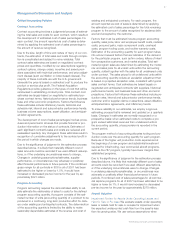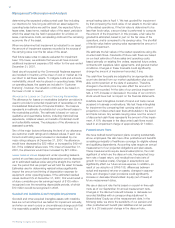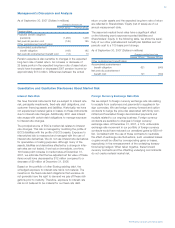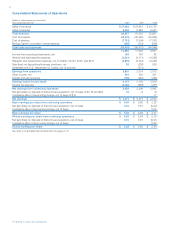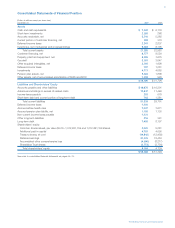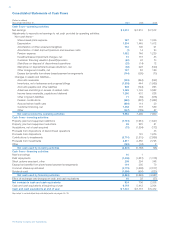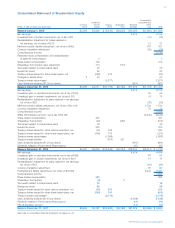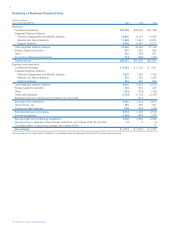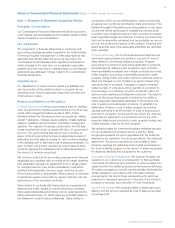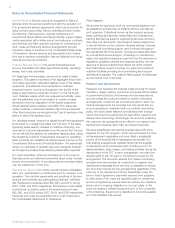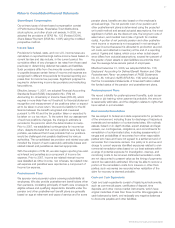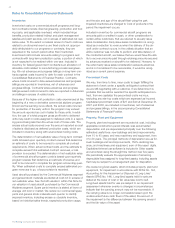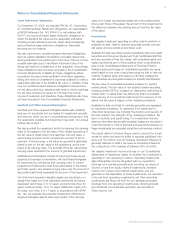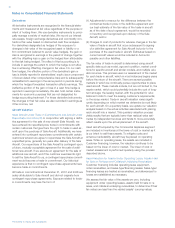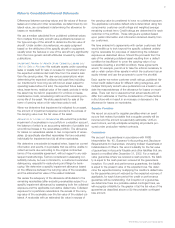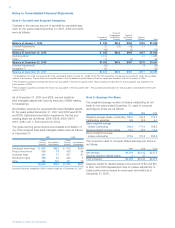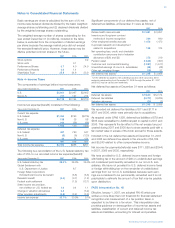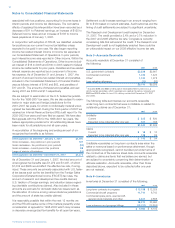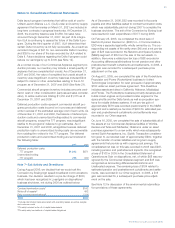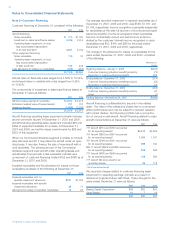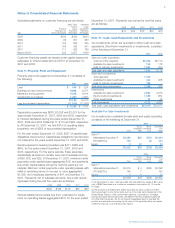Boeing 2007 Annual Report Download - page 50
Download and view the complete annual report
Please find page 50 of the 2007 Boeing annual report below. You can navigate through the pages in the report by either clicking on the pages listed below, or by using the keyword search tool below to find specific information within the annual report.47
Notes to Consolidated Financial Statements
Share-Based Compensation
Our primary types of share-based compensation consist
of Performance Shares, ShareValue Trust distributions,
stock options, and other stock unit awards. In 2005, we
adopted the provisions of SFAS No. 123 (Revised 2004),
Share-Based Payment (SFAS No. 123R) using the modified
prospective method.
Income Taxes
Provisions for federal, state, and non-U.S. income taxes are
calculated on reported Earnings before income taxes based on
current tax law and also include, in the current period, the
cumulative effect of any changes in tax rates from those used
previously in determining deferred tax assets and liabilities.
Such provisions differ from the amounts currently receivable
or payable because certain items of income and expense are
recognized in different time periods for financial reporting pur-
poses than for income tax purposes. Significant judgment is
required in determining income tax provisions and evaluating
tax positions.
Effective January 1, 2007, we adopted Financial Accounting
Standards Board (FASB) Interpretation No. (FIN) 48,
Accounting for Uncertainty in Income Taxes (FIN 48), which
requires a more-likely-than-not threshold for financial statement
recognition and measurement of tax positions taken or expect-
ed to be taken in a tax return. We record a liability for the dif-
ference between the benefit recognized and measured
pursuant to FIN 48 and the tax position taken or expected to
be taken on our tax return. To the extent that our assessment
of such tax positions changes, the change in estimate is
recorded in the period in which the determination is made.
Prior to 2007, we established contingencies for income tax
when, despite the belief that our tax positions were fully sup-
portable, we believed that it was probable that our positions
would be challenged and possibly disallowed by various
authorities. The consolidated tax provision and related accruals
included the impact of such reasonably estimable losses and
related interest and penalties as deemed appropriate.
With the adoption of FIN 48, we also began reporting tax-relat-
ed interest and penalties as a component of Income tax
expense. Prior to 2007, income tax-related interest income
was classified as Other income, net, whereas, tax-related inter-
est expense and penalties were reported as a component of
Income tax expense.
Postretirement Plans
We sponsor various pension plans covering substantially all
employees. We also provide postretirement benefit plans other
than pensions, consisting principally of health care coverage to
eligible retirees and qualifying dependents. Benefits under the
pension and other postretirement benefit plans are generally
based on age at retirement and years of service and for some
pension plans, benefits are also based on the employee’s
annual earnings. The net periodic cost of our pension and
other postretirement plans is determined using the projected
unit credit method and several actuarial assumptions, the most
significant of which are the discount rate, the long-term rate of
asset return, and medical trend (rate of growth for medical
costs). A portion of net periodic pension and other postretire-
ment income or expense is not recognized in net earnings in
the year incurred because it is allocated to production as prod-
uct costs, and reflected in inventory at the end of a reporting
period. If gains and losses, which occur when actual experi-
ence differs from actuarial assumptions, exceed ten percent of
the greater of plan assets or plan liabilities we amortize them
over the average future service period of employees.
Effective December 31, 2006, we adopted SFAS No. 158,
Employers’ Accounting for Defined Benefit Pension and Other
Postretirement Plans –
an amendment of FASB Statements
No. 87, 88, 106 and 132(R) (SFAS No. 158) which requires
that the Consolidated Statements of Financial Position reflect
the funded status of the pension and postretirement plans.
Postemployment Plans
We record a liability for postemployment benefits, such as sev-
erance or job training, when payment is probable, the amount
is reasonably estimable, and the obligation relates to rights that
have vested or accumulated.
Environmental Remediation
We are subject to federal and state requirements for protection
of the environment, including those for discharge of hazardous
materials and remediation of contaminated sites. We routinely
assess, based on in-depth studies, expert analyses and legal
reviews, our contingencies, obligations, and commitments for
remediation of contaminated sites, including assessments of
ranges and probabilities of recoveries from other responsible
parties who have and have not agreed to a settlement and of
recoveries from insurance carriers. Our policy is to accrue and
charge to current expense identified exposures related to envi-
ronmental remediation sites based on our best estimate within
a range of potential exposure for investigation, cleanup, and
monitoring costs to be incurred. Estimated remediation costs
are not discounted to present value as the timing of payments
cannot be reasonably estimated. We may be able to recover a
portion of the remediation costs from insurers or other third-
parties; such recoveries are recorded when realization of the
claim for recovery is deemed probable.
Cash and Cash Equivalents
Cash and cash equivalents consist of highly liquid instruments,
such as commercial paper, certificates of deposit, time
deposits, and other money market instruments, which have
original maturities of less than three months. We aggregate our
cash balances by bank, and reclassify any negative balances
to Accounts payable and other liabilities.
The Boeing Company and Subsidiaries


